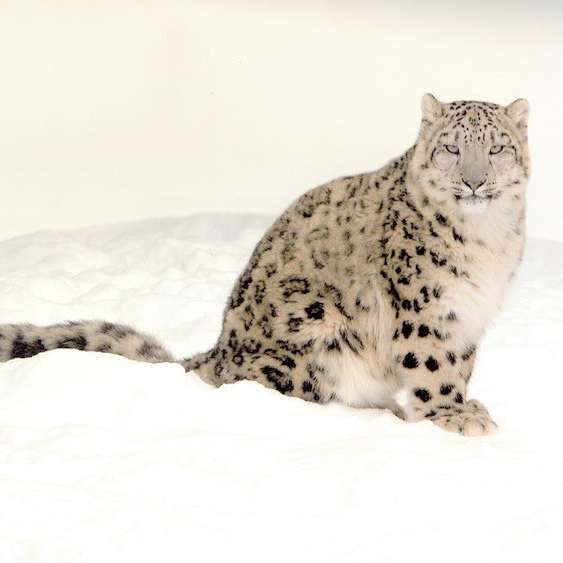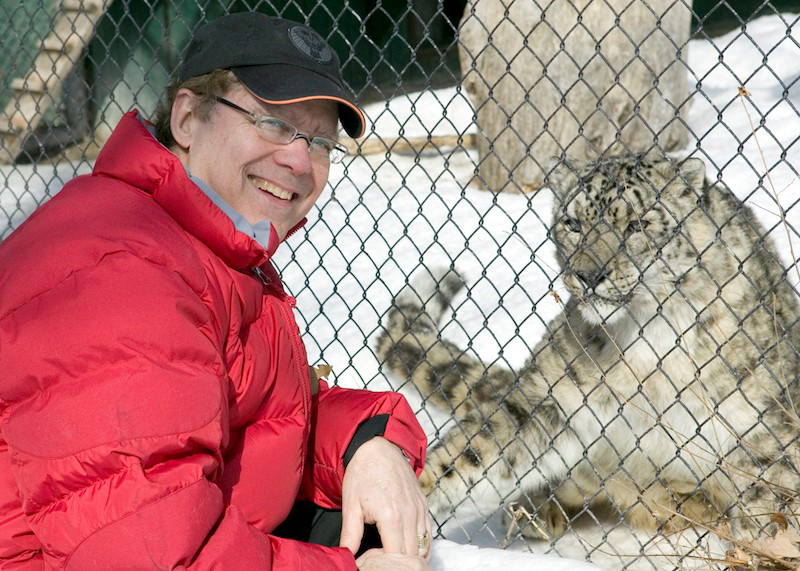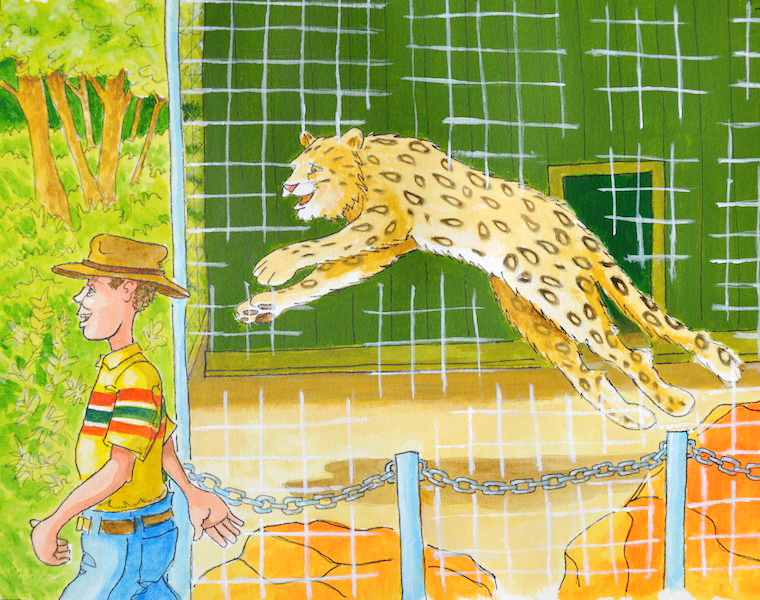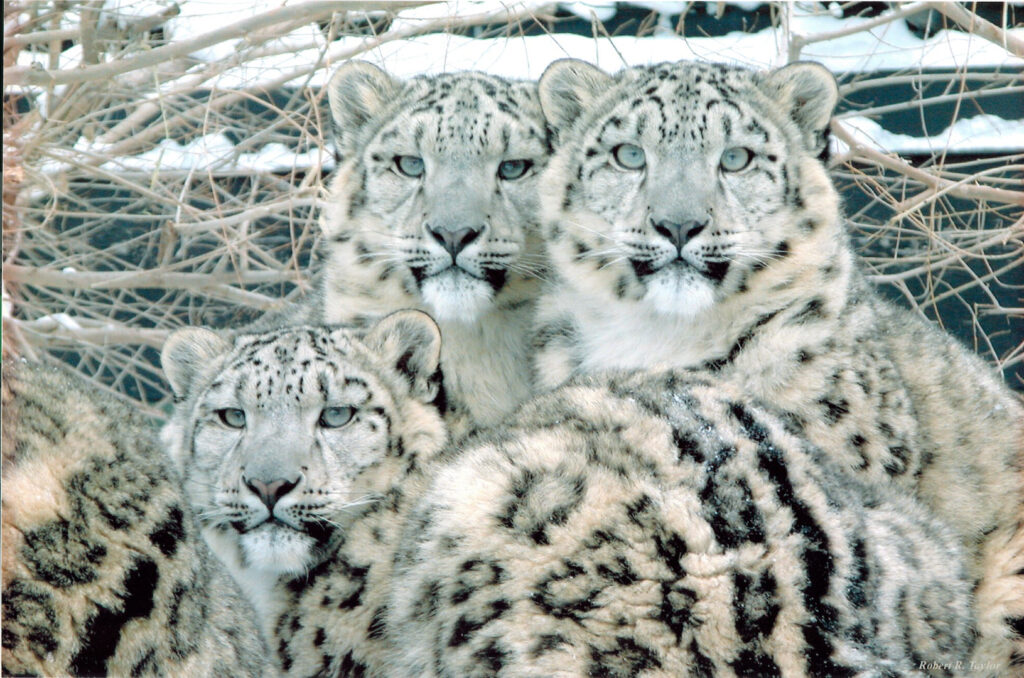by Robert E. Wrigley
While I was employed as the Curator of the Assiniboine Park Zoo, one question I was asked repeatedly while giving talks or leading tours was “What is your favourite animal?” Without a doubt, my choice was the Snow Leopard, and in particular, our magnificent male, Dmitri. He was an exceptional animal both physically and in his aristocratic mannerisms. Built for speed and powerful leaps, he moved with the grace of a fast-flowing stream, never suffering an awkward step or momentary loss of balance. His regal persona stopped visitors in their tracks, and the intensity of his glare was arresting, capable of sending chills down a visitor’s neck. Dmitri was a fine-tuned predator, truly a product of millions of years of evolution in a world of deep snow, howling winds, and rocky mountainsides so steep that one slip meant almost certain death.

I once watched a television show narrated by the famous naturalist-broadcaster David Attenborough in which a female Snow Leopard was filmed in a death-defying pursuit of a markhor (a large species of wild goat) down a near-vertical mountain slope in Pakistan. It was one of the most-dramatic, predator-prey chases I have ever seen. The leopard managed to maintain its balance after semi-controlled falling for many metres in each bound, landing on broken rock and absorbing the great force of gravity with its muscular limbs acting as shock absorbers. Its reckless speed demonstrated a precision of eye-brain-body coordination which was hard to comprehend in real time, and any miscalculation in a procession of rapid decisions would have resulted in a fatal fall for hundreds of metres onto sharp-edged boulders. At the end of this scene, the markhor escaped by tumbling into a raging river. In the next attack sequence with another markhor, the leopard was successful, and with super-feline strength dragged its heavy prey back up the slope for a kilometer to reach its den, where its cub was waiting for food. How the photographer managed to capture such action of one of the world’s most-secretive big cats was amazing.
Since Dmitri’s enclosure was close to my office, I could not resist visiting him almost daily, and soon we developed a special bond. This was likely stimulated by a spray of his favourite perfume – men’s Bvlgari. On each occasion, Dmitri curled up his nose and lips, began to salivate profusely, and then repeatedly rubbed his cheek and shoulder with force against the fence wire right beside me, while uttering little enduring ‘puff-puff’ calls, and then finally rolling over onto his back, as if he wanted me to scratch his tummy. I used the long antenna of my radio to tickle him (through the fence wire), and it was obvious he did not want me to stop. When I backed away to leave, he leapt instantly to his feet, and placing his front paws high onto the chain-link fence, he executed the powerful stretching movements of sharpening his impressive claws. In fact, he applied such pressure that sometimes pieces of his claws snapped off and flew through the air, something I obviously did not want to encourage. The fragrance turned him into a big kitten, every time!

Dmitri and I shared a special game, which I liked to spring on admiring visitors standing along the enclosure’s barrier fence. As I approached his exhibit, Dmitri suddenly spotted me, although I was sometimes up to 50 metres away. Transforming instantly from a bored, recumbent slouch into to an energized athlete, he crouched and crept over to hide behind a large boulder, usually leaving his exceptionally long tail exposed and twitching, evidence of his great excitement. Then slowly, the top of his head (with ears flattened) and his big eyes appeared just above the boulder, watching intently my every move. I walked towards him, making no eye contact and giving no indication I was aware he was there. He saw right past the visitors, ignoring them completely. In fact, he was hunting me! As I drew near, I turned sharply and began to walk away, which was his signal to initiate an ambush. With astonishing speed, Dmitri covered the length of the exhibit in only two bounds and then leapt almost 3 metres to the top wall of the enclosure, striking the chain-link wire with all his weight, and causing the gravel stuck between his toes to hit me in the back of my head. All the visitors jumped back in shock, as the unexpected attack happened so fast. As Dmitri sneaked back behind the boulder for round two, I calmed the visitors by explaining who I was, and that this was just a game we liked to play for behavioural enrichment (on both our parts), but it also presented such a dramatic demonstration of his extraordinary predatory prowess.

Dmitri was a superlative representative of his race in another way. He and his mate, Lhasa, were incredibly compatible, a most-unusual trait for Snow Leopards, as they prefer to live alone (both in the wild and in captivity), except for a brief period during the breeding season. While most zoos have had no or limited success breeding this species, our pair raised an amazing 16 surviving offspring over the years – a tremendous contribution to the captive population in facilities around the world. When we submitted our annual report on the status of our collection of Snow Leopards for the Species Survival Program (operated by the American Association of Zoos and Aquariums for endangered species), the coordinator informed me that we must have erred, because we reported that Dmitri had bred his mate successfully at age 19 – several years beyond the known limit for the species. But no, there was no mistake; Dmitri and Lhasa were really this extraordinary. He lived for three additional years, a respectful age for any big cat. Dmitri’s name was based on the ancient Greek word, Demetrios, meaning ‘devoted to Demeter,’ the Goddess of Fertility and the Cycle of Life, and so considering his compatibility and devotion to Lhasa, this name fitted him perfectly.

I missed Dmitri so much after he died that I commissioned an artist friend to paint his accurate portrait from photographs, which now hangs in my family room. I will always remember kneeling down in front of him, with only half a metre separating us through the enclosure wire, as we searched each other’s eyes and facial expressions for minutes at a time. What was he thinking behind those huge, expressive, greenish-yellow eyes? It was as if I could peer into the distant past of his race in the mountains of Central Asia, tragically now on the verge of extinction. Here was one of Nature’s premier killing machines, appearing to gain immense pleasure just from my presence. It was a truly humbling and emotional moment, which I will forever treasure. My wonderful Dmitri; my favourite animal.
One of 230 real-life stories from Dr. Wrigley’s book; “Chasing Nature: An Ecologist’s Lifetime of Adventures and Observations.” Available for $36 by contacting robertwrigley@mts.net

